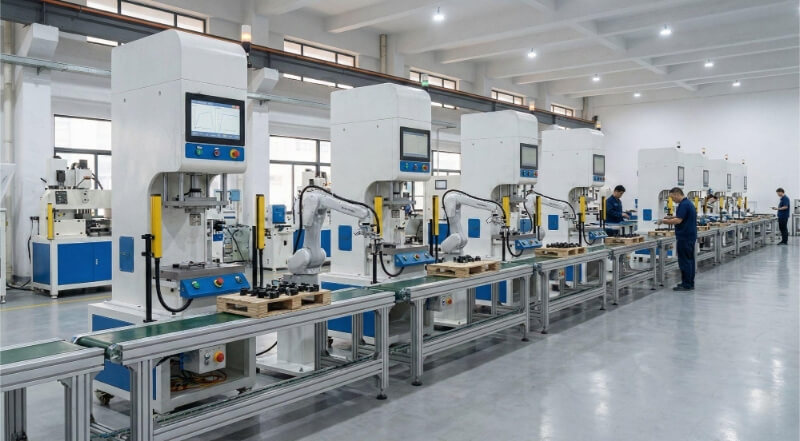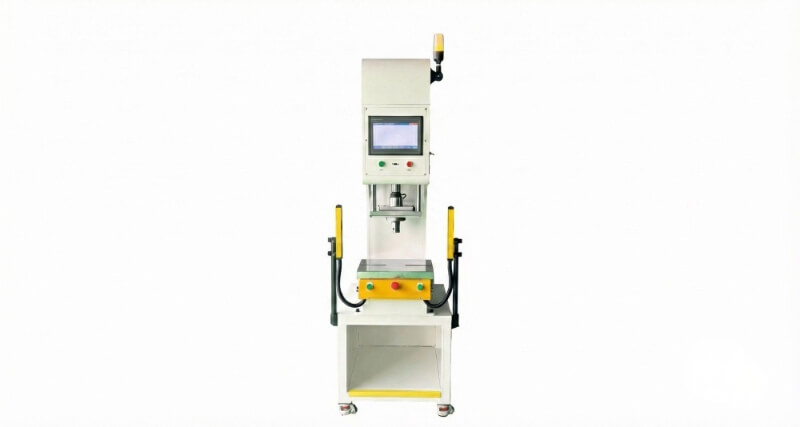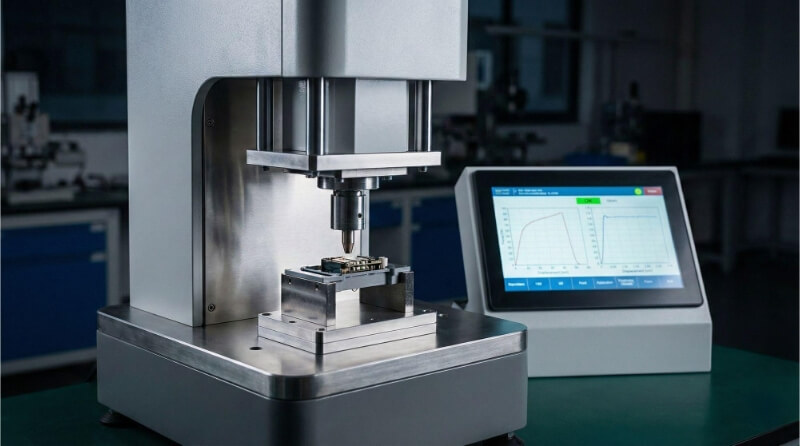المنتجات البلاستيكية موجودة في كل مكان في حياتنا اليومية. ولكن هل تساءلت يومًا كيف يصنع المصنعون أجزاءً معقدة من مواد متعددة؟ يكافح الكثيرون لإنتاج مكونات متينة ومتعددة المواد بكفاءة. غالبًا ما يؤدي هذا التحدي إلى زيادة التكاليف وأوقات إنتاج أطول. يوفر التشكيل بالإدخال حلاً لهذه المشكلات.
تفتح هذه العملية المبتكرة إمكانيات جديدة لتصميم المنتجات وكفاءة التصنيع. دعنا نستكشف كيف تعمل عملية التشكيل بالإدخال ولماذا قد تكون الخيار الصحيح لمشروعك القادم.

فهم القوالب الداخلية
ما هو القولبة الداخلية؟
القولبة بالإدخال هي تقنية تصنيع متطورة. وهي تجمع بين مادتين أو أكثر في مكون واحد متماسك. تبدأ العملية بوضع حشوة مصنوعة مسبقاً في تجويف القالب. ثم يتم حقن البلاستيك المنصهر حولها. وعندما يبرد البلاستيك ويتصلب، فإنه يتماسك مع الملحق.
المزايا الرئيسية لقولبة الإدخال في التصنيع
يوفر التشكيل بالإدخال العديد من الفوائد للمصنعين ومصممي المنتجات. فهي تعمل على تبسيط الإنتاج من خلال التخلص من خطوات التجميع الثانوية، مما يؤدي إلى تسريع أوقات الإنتاج وخفض تكاليف العمالة.
تعزز هذه التقنية أيضًا من متانة المنتج. تقلل الرابطة القوية بين البلاستيك والإدخال من خطر انفصال المكونات.
يسمح التشكيل بالإدخال بتصميمات معقدة يصعب أو يستحيل تحقيقها بالطرق التقليدية. فهي تتيح إنشاء أجزاء ذات تفاوتات دقيقة وأشكال هندسية معقدة.
يمكن لهذه العملية أن تقلل بشكل كبير من هدر المواد. إن دمج المكونات مباشرة في الجزء المقولب يلغي الحاجة إلى المواد الزائدة المستخدمة في الأجزاء التقليدية طرق التجميع.
أنواع عمليات التشكيل بالقالب الداخلي
صب القوالب العمودية الداخلية
تستخدم القوالب الرأسية القوالب الرأسية ماكينة قولبة بالحقن عمودياً. يفتح القالب ويغلق على طول محور عمودي. هذا الإعداد مثالي للإدخالات التي يجب وضعها بدقة.
تساعد الجاذبية في الحفاظ على الإدخالات في مكانها أثناء عملية التشكيل. وهذا يجعل القولبة الرأسية مناسبة للقطع ذات الإدخالات المتعددة أو الأشكال الهندسية المعقدة.
صب القوالب الداخلية الأفقية
تستخدم القوالب الأفقية المُدخَلة ماكينة قولبة بالحقن ذات اتجاه أفقي. يفتح القالب ويغلق على طول محور أفقي، ويستخدم هذا التكوين بشكل شائع في الإنتاج بكميات كبيرة.
غالبًا ما يكون للماكينات الأفقية أوقات دورات أسرع من الماكينات الرأسية. وهي مناسبة تمامًا للقِطع ذات تكوينات إدراج أبسط، كما أن وضع الإدخال الآلي أسهل في التنفيذ مع الماكينات الأفقية.
صب القوالب الدوارة الدوارة
تستخدم القوالب الدوارة الدوارة طاولة دوارة مع محطات قوالب متعددة. تقوم كل محطة بتنفيذ جزء مختلف من العملية، مما يسمح بالإنتاج المستمر.
أثناء دوران الطاولة، يتم تحميل الحشوات في إحدى المحطات، ويتم حقن البلاستيك في محطة أخرى، ثم يتم تبريد الجزء وإخراجه في المحطات التالية.
القولبة الآلية للإدخال الآلي
يشتمل التشكيل الآلي للإدخال الآلي على أنظمة روبوتية لوضع الإدخال ومناولة القِطع. وهذا يقلل من الحاجة إلى العمل اليدوي ويزيد من سرعة الإنتاج.
يمكن للروبوتات وضع الإدخالات بدقة واتساق عاليين. كما يمكنها التعامل مع إدخالات متعددة في وقت واحد.
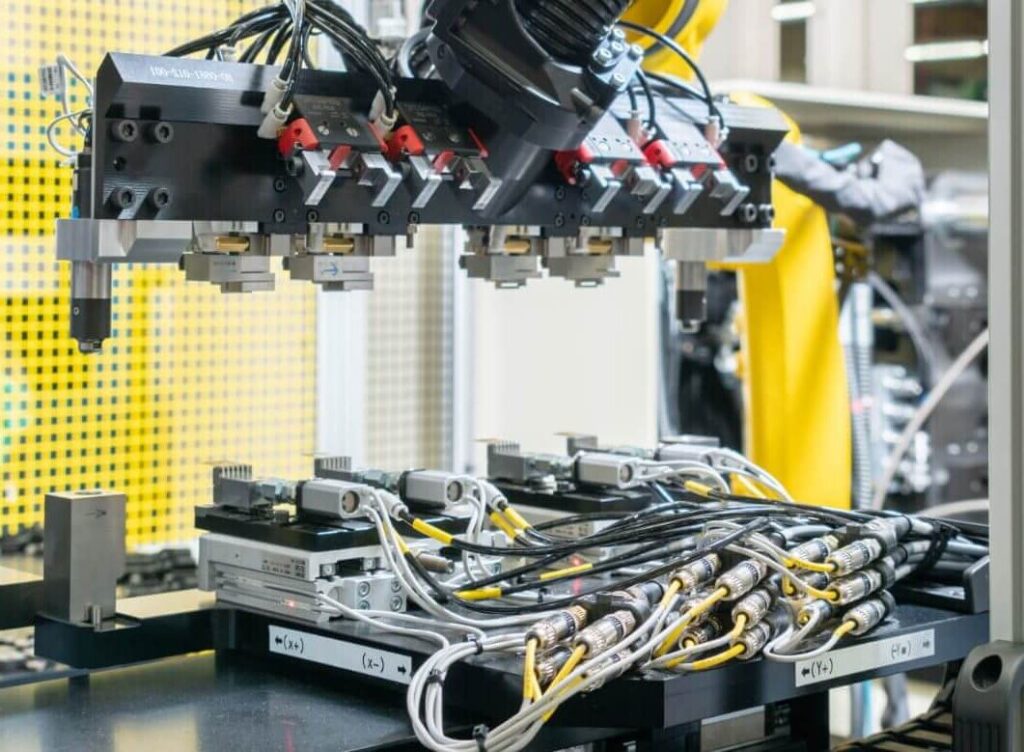
عملية التشكيل بالقالب الداخلي: خطوة بخطوة
يتبع التشكيل الداخلي تسلسل دقيق من الخطوات. وفيما يلي شرح تفصيلي للعملية:
إعداد الإدخال
- اختر مادة الإدخال المناسبة (معدن، بلاستيك، إلخ).
- نظف الملحق لإزالة أي ملوثات
- ضع أي طلاءات أو معالجات ضرورية لتحسين الالتصاق
إعداد القالب
- تصميم وتصنيع قالب مخصص مزود بتجاويف للإدخال والبلاستيك
- تركيب القالب في ماكينة القولبة بالحقن
- ضبط معلمات الماكينة (درجة الحرارة، والضغط، ووقت الدورة)
إدراج الموضع
- وضع الملحق يدويًا أو تلقائيًا في تجويف القالب
- تأكد من المحاذاة والتوجيه الصحيحين للإدخال
حقن البلاستيك
- إغلاق القالب
- احقن البلاستيك المنصهر في تجويف القالب حول المدخل
- قم بالضغط لضمان ملء القالب بالكامل
التبريد والطرد
- يُترك البلاستيك ليبرد ويتصلب
- افتح القالب
- قم بإخراج الجزء النهائي مع الملحق المدمج
تصميم الأدوات والقوالب لقولبة القوالب المدخلة
عوامل يجب مراعاتها في تصميم القالب
يتطلب تصميم قوالب القوالب المدمجة تخطيطًا دقيقًا. يجب أن يستوعب القالب كلاً من الجزء البلاستيكي والقطعة البلاستيكية المدمجة، مما يؤدي في كثير من الأحيان إلى تصميمات أكثر تعقيدًا من قوالب الحقن القياسية.
اختيار المواد للقالب أمر بالغ الأهمية. يجب أن يتحمل القالب درجات الحرارة والضغوط العالية. كما يجب أن يقاوم التآكل الناتج عن تكرار وضع القالب في القالب وقذف القِطع.
يتطلب موقع البوابة اهتمامًا خاصًا في قولبة الحشوة. يجب وضع البوابات لضمان التدفق المناسب للبلاستيك حول الإدخال.
تصميم قناة التبريد هو عامل حاسم آخر. يضمن التبريد الفعال جودة القطعة المتسقة ويقلل من أزمنة الدورات.
أهمية الدقة في وضع الإدخال في مكان الإدخال
يعد الوضع الدقيق للإدخال هو مفتاح نجاح صب الإدخال. يجب أن يشتمل تصميم القالب على ميزات لتأمين الملحق في الموضع الصحيح. قد يتضمن ذلك دبابيس أو تجاويف أو آليات تحديد موقع أخرى.
عادةً ما تكون تفاوتات وضع الإدخال ضيقة للغاية. فحتى الاختلالات الصغيرة يمكن أن تؤدي إلى عيوب أو مشاكل وظيفية في الجزء النهائي.
يجب أن يراعي القالب أيضًا التمدد الحراري. حيث يتمدد كل من الحشوة ومادة القالب عند التسخين. يجب على المصممين مراعاة ذلك للحفاظ على الدقة طوال دورة التشكيل.
تصميم القوالب متعددة التجاويف لقولبة القوالب الداخلية
تعمل القوالب متعددة التجاويف على زيادة كفاءة الإنتاج في قولبة القوالب المدخلة. تنتج هذه القوالب أجزاء متعددة في دورة واحدة. ومع ذلك، فإنها تمثل تحديات فريدة من نوعها في تطبيقات صب القوالب المدخلة.
يجب أن يكون كل تجويف في القالب متعدد التجاويف متطابقًا. وهذا يضمن جودة القطعة المتسقة عبر جميع التجاويف. ويصبح تحقيق هذا المستوى من الدقة أكثر صعوبة عند دمج إدخالات.
يصبح تحميل المدخلات أكثر تعقيدًا في القوالب متعددة التجاويف. يجب على المصممين النظر في كيفية وضع المشغلين أو الأنظمة الآلية للإدخالات في جميع التجاويف بكفاءة.
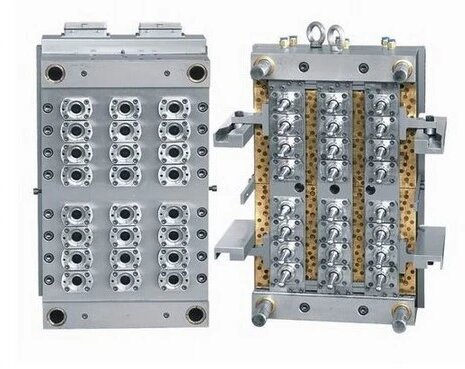
صب القوالب الداخلية مقابل القوالب المتراكبة
تحديد الاختلافات
القولبة بالإدخال والقولبة الزائدة عمليتان مرتبطتان ببعضهما البعض، ولكن بينهما اختلافات رئيسية:
إدراج القوالب:
- يتم وضع الإدخالات في القالب قبل الحقن
- إنشاء جزء واحد متكامل
- تستخدم عادةً حشوات معدنية أو بلاستيكية صلبة
صب القوالب الزخرفية:
- ينطوي على صب فوق جزء موجود
- إنشاء مكون متعدد الطبقات أو متعدد المواد
- غالبًا ما تستخدم مواد أكثر ليونة على ركائز أكثر صلابة
متى يجب استخدام القوالب الداخلية مقابل القوالب المتراكبة
اختر إدراج القوالب عندما:
- تحتاج إلى تضمين مكونات معدنية
- القوة الهيكلية هي الأولوية
- أنت تقوم بإنشاء موصلات كهربائية
اختر القوالب المفرطة عندما:
- إضافة تماسك أو توسيد لجزء ما
- إنشاء مكونات متعددة الألوان
- ختم أو حماية جزء موجود
يعتمد الاختيار على متطلبات المنتج والمواد وأهداف التصميم.
المواد المستخدمة في صب القوالب الداخلية
المواد البلاستيكية الشائعة لصب القوالب الداخلية
يعمل التشكيل بالإدخال مع مجموعة كبيرة من اللدائن الحرارية. تشمل الخيارات الشائعة ما يلي:
- ABS (أكريلونيتريل بوتادين ستايرين)
- البولي كربونات (PC)
- نايلون (بنسلفانيا)
- البولي بروبلين (PP)
- PBT (بولي بيوتيلين تيريفثاليت)
يوفر كل بلاستيك خصائص فريدة مثل القوة أو الحرارة أو المقاومة الكيميائية.
المعادن والإدخالات الأخرى المستخدمة في قولبة القوالب الداخلية
تشمل مواد الإدخال الشائعة ما يلي:
- نحاس
- فُولاَذ
- الألومنيوم
- الفولاذ المقاوم للصدأ
- إدخالات ملولبة
- المغناطيسات
- مكونات السيراميك
توفر هذه الإضافات وظائف محددة أو خصائص محسنة للجزء النهائي.
معايير اختيار مواد الإدخال
اختر مواد الإدراج بناءً على ما يلي:
- التوافق مع بلاستيك القوالب
- معدلات التمدد الحراري
- الخواص الميكانيكية المطلوبة
- احتياجات مقاومة التآكل
- اعتبارات التكلفة
- التوصيل الكهربائي (إذا لزم الأمر)
يضمن اختيار المواد المناسبة وجود رابطة قوية وأداء مثالي للمنتج النهائي.
تطبيقات التشكيل بالقالب الداخلي
تطبيقات صناعة السيارات
يُستخدم التشكيل بالإدخال على نطاق واسع في صناعة السيارات:
- موصلات كهربائية لتسخير الأسلاك
- مقابض تبديل التروس مع حشوات معدنية
- مقابض أبواب مزودة بقلب مقوى
- مكونات نظام الوقود
- حوامل المحرك مع البطانات المعدنية المدمجة
تعمل هذه التطبيقات على تحسين المتانة وتقليل وقت التجميع وتحسين جودة السيارة.
الأجهزة الطبية والرعاية الصحية
في المجال الطبي، يتيح إدخال القوالب الطبية:
- أدوات جراحية ذات حشوات معدنية
- أجهزة توصيل الأدوية بمكونات دقيقة
- مبيتات معدات التشخيص
- أدوات طب الأسنان ذات الأطراف المعدنية
- الغرسات الطبية بمواد متوافقة حيوياً
تضمن هذه التقنية الدقة والتعقيم والموثوقية في تطبيقات الرعاية الصحية الحرجة.
الالكترونيات والسلع الاستهلاكية
يُحدث التشكيل بالإدخال ثورة في صناعة الإلكترونيات:
- حافظات الهواتف الذكية المزودة بهوائيات مدمجة
- مفصلات الكمبيوتر المحمول مع تعزيزات معدنية
- أختام مقاومة للماء للإلكترونيات الخارجية
- أدوات كهربائية بمكونات معدنية مدمجة
- أجهزة التحكم في الأجهزة المنزلية والمفاتيح الكهربائية
فهو يسمح بتصميمات أكثر أناقة ومتانة محسّنة ووظائف محسّنة في المنتجات اليومية.
الفضاء الجوي والدفاع
في مجال الطيران، يساهم التشكيل بالإدخال في:
- مكونات هيكلية خفيفة الوزن
- موصلات كهربائية لإلكترونيات الطيران
- علب المستشعرات المزودة بإلكترونيات مدمجة
- لوحات تحكم بدوائر متكاملة
- مكونات نظام الوقود مع إدخالات معدنية
تلبي هذه التطبيقات معايير الصناعة الصارمة للأداء والموثوقية في البيئات الصعبة.
التحديات في صب القوالب الداخلية
العيوب الشائعة في صب القوالب الداخلية
تعد إزاحة الحشوة مشكلة متكررة. تحدث عندما تتحرك الحشوة أثناء عملية التشكيل. يمكن أن يؤدي ذلك إلى اختلال محاذاة أو انكشاف الإدخال في الجزء النهائي.
الوميض، أو البلاستيك الزائد حول الحشوة هو عيب شائع آخر. يحدث عندما يتسرب البلاستيك بين الحشوة وسطح القالب.
يمكن أن يحدث ملء غير مكتمل حول الملحق، مما يؤدي إلى وجود فراغات أو نقاط ضعف في الجزء. وغالبًا ما يحدث ذلك بسبب عدم كفاية ضغط الحقن أو سوء تصميم القالب.
يمثل الاعوجاج تحديًا في قولبة القوالب المدخلة. يمكن أن تتسبب معدلات التبريد المختلفة للمدخل والبلاستيك في حدوث إجهاد في الجزء. ويؤدي هذا الإجهاد إلى الالتواء أو الالتواء عندما يبرد الجزء.
يمكن أن يحدث انسحاب الملحق أثناء إخراج الجزء. ويحدث ذلك عندما لا تكون الرابطة بين الملحق والبلاستيك قوية بما فيه الكفاية، مما يؤدي إلى انفصال الملحق عن الجزء المقولب.
معالجة الاعوجاج واختلال المحاذاة والفراغات
لمنع الاعوجاج، يدرس المصممون بعناية اختيار المواد. يقلل اختيار المواد ذات معدلات التمدد الحراري المتشابهة من الضغوط الداخلية. كما يساعد التصميم المناسب لقناة التبريد في القالب على التحكم في الالتواء.
غالبًا ما يعالج تحسين الاحتفاظ بالمدخلات في القالب مشاكل عدم المحاذاة. قد ينطوي ذلك على إضافة دبابيس تحديد الموقع أو تغيير هندسة الإدخال. تشتمل بعض القوالب على حساسات للتحقق من وضع الحشوة قبل الحقن.
تتم مكافحة الفراغات عادةً عن طريق تحسين معلمات الحقن. يمكن أن تساعد زيادة ضغط الحقن أو ضبط درجة حرارة القالب. في بعض الحالات، يكون من الضروري إعادة تصميم الجزء أو القالب لتحسين التدفق حول الحشوة.
يلعب موقع البوابة دورًا حاسمًا في معالجة هذه المشكلات. يضمن الموضع الاستراتيجي للبوابة تدفق البلاستيك بشكل متساوٍ حول الملحق، مما يساعد على منع الفراغات وتقليل خطر انزياح الملحق.
كيفية التغلب على قيود التصميم والمواد
غالبًا ما ينطوي التغلب على قيود التصميم على حل المشاكل بطريقة مبتكرة. تتطلب الأشكال الهندسية المعقدة للأجزاء عمليات صب متعددة الخطوات. ويمكن أن يشمل ذلك التشكيل المسبق لخصائص معينة قبل خطوة التشكيل النهائي للإدخال.
يمكن معالجة مشكلات توافق المواد من خلال المعالجات السطحية. يمكن لتقنيات مثل المعالجة بالبلازما أو استخدام معززات الالتصاق تحسين الترابط بين المواد غير المتوافقة.
يتم استخدام حلول تبريد مبتكرة عند التعامل مع الإدخالات الحساسة لدرجات الحرارة المرتفعة. قد يتضمن ذلك قنوات تبريد مطابقة في القالب أو إدخالات التبريد المسبق قبل الوضع.
تكون المعالجة الآلية بعد التشكيل ضرورية في بعض الأحيان للأجزاء التي تتطلب تفاوتات ضيقة. وهذا يسمح بالتعديل الدقيق للأبعاد الحرجة التي قد يكون من الصعب تحقيقها من خلال التشكيل وحده.
عندما لا تفي مواد الإدخال القياسية بالمتطلبات، يتم تطوير سبائك مخصصة أو مواد مركبة. يمكن أن توفر هذه المواد المتخصصة خصائص فريدة مصممة خصيصًا لتطبيقات محددة.
خاتمة
يمثل التشكيل بالإدخال تقنية تصنيع قوية في الإنتاج الحديث. فهي تجمع بين نقاط قوة المواد المختلفة، مما يؤدي إلى إنشاء أجزاء متكاملة ذات وظائف محسنة. تعمل هذه العملية على تبسيط الإنتاج، وتقلل من خطوات التجميع، وغالبًا ما تنتج منتجات أكثر متانة.
كما أوضحنا، يوفر التشكيل بالإدخال العديد من المزايا. فهي تسمح بالتصميمات المعقدة، وتحسّن من قوة القِطع، ويمكن أن تقلل بشكل كبير من تكاليف الإنتاج في سيناريوهات الحجم الكبير.
الأسئلة الشائعة
ما هو العمر الافتراضي للمنتج المصبوب بالقالب؟
يختلف العمر الافتراضي للمنتج المقولب بالملحقات باختلاف المواد المستخدمة واستخدامه. وبصفة عامة، تتمتع هذه المنتجات بعمر افتراضي ممتاز بسبب الرابطة القوية بين الحشوة والبلاستيك.
كيف يحسن التشكيل بالإدخال من متانة المنتج؟
تعزز القوالب المدمجة بشكل كبير من متانة المنتج من خلال الجمع بين نقاط قوة المواد المختلفة. توفر الحشوة المدمجة، التي غالباً ما تكون معدنية، تعزيزاً هيكلياً، بينما يوفر البلاستيك المحيط بها حماية ووظائف إضافية.
هل يمكن استخدام القولبة بالإدخال مع أنواع مختلفة من البلاستيك والمعادن؟
نعم، تُعد قوالب الإدخالات متعددة الاستخدامات للغاية ويمكن استخدامها مع العديد من المواد البلاستيكية والمعادن. وتشمل المواد البلاستيكية الشائعة ABS، والبولي كربونات، والنايلون، بينما يمكن صنع الحشوات المعدنية من النحاس الأصفر أو الفولاذ أو الألومنيوم.
كيف تختار المادة المناسبة لقولبة الإدخال؟
يتضمن اختيار المادة المناسبة لقولبة الإدخال النظر في عدة عوامل. وتشمل هذه العوامل الاستخدام المقصود للمنتج والخصائص الميكانيكية المطلوبة وبيئة التشغيل وقيود التكلفة. يعد تقييم التوافق بين مادة الإدخال والبلاستيك المصبوب أمرًا بالغ الأهمية، مع الأخذ في الاعتبار جوانب مثل معدلات التمدد الحراري والتفاعلات الكيميائية.
مهلا، أنا كيفن لي

على مدى السنوات العشر الماضية، كنت منغمسًا في أشكال مختلفة من تصنيع الصفائح المعدنية، وشاركت رؤى رائعة هنا من تجاربي عبر ورش العمل المتنوعة.
ابقى على تواصل

كيفن لي
لدي أكثر من عشر سنوات من الخبرة المهنية في تصنيع الصفائح المعدنية، وتخصصت في القطع بالليزر، والثني، واللحام، وتقنيات معالجة الأسطح. كمدير فني في شنغن، أنا ملتزم بحل تحديات التصنيع المعقدة ودفع الابتكار والجودة في كل مشروع.

